Singapore Airport Privatization: Advantages, Risks, and Case Study
VerifiedAdded on 2022/09/06
|11
|2837
|33
Report
AI Summary
This report provides a comprehensive analysis of airport privatization, focusing on the case of Singapore. It begins with an executive summary highlighting the importance of airports in air transport networks and the considerations surrounding privatization. The report selects Changi Airport and Paya Lebar Airport for detailed examination, determining their ownership structures and exploring different types of privatization models. It then delves into the advantages of privatization, such as improved operating efficiencies, introduction of modern management styles, and better investment decisions, using the Changi Airport as a prime example. The report also discusses potential risks, including costly financing, legal hurdles, and vested interests of airlines. The conclusion summarizes the benefits of privatization, including increased profits and efficiencies, while also acknowledging potential drawbacks like reduced government revenue and regulatory challenges. The report emphasizes the importance of a profit incentive for private firms to enhance operational efficiencies and reduce expenses. The findings offer insights into the complexities of airport privatization and its impact on the aviation industry.
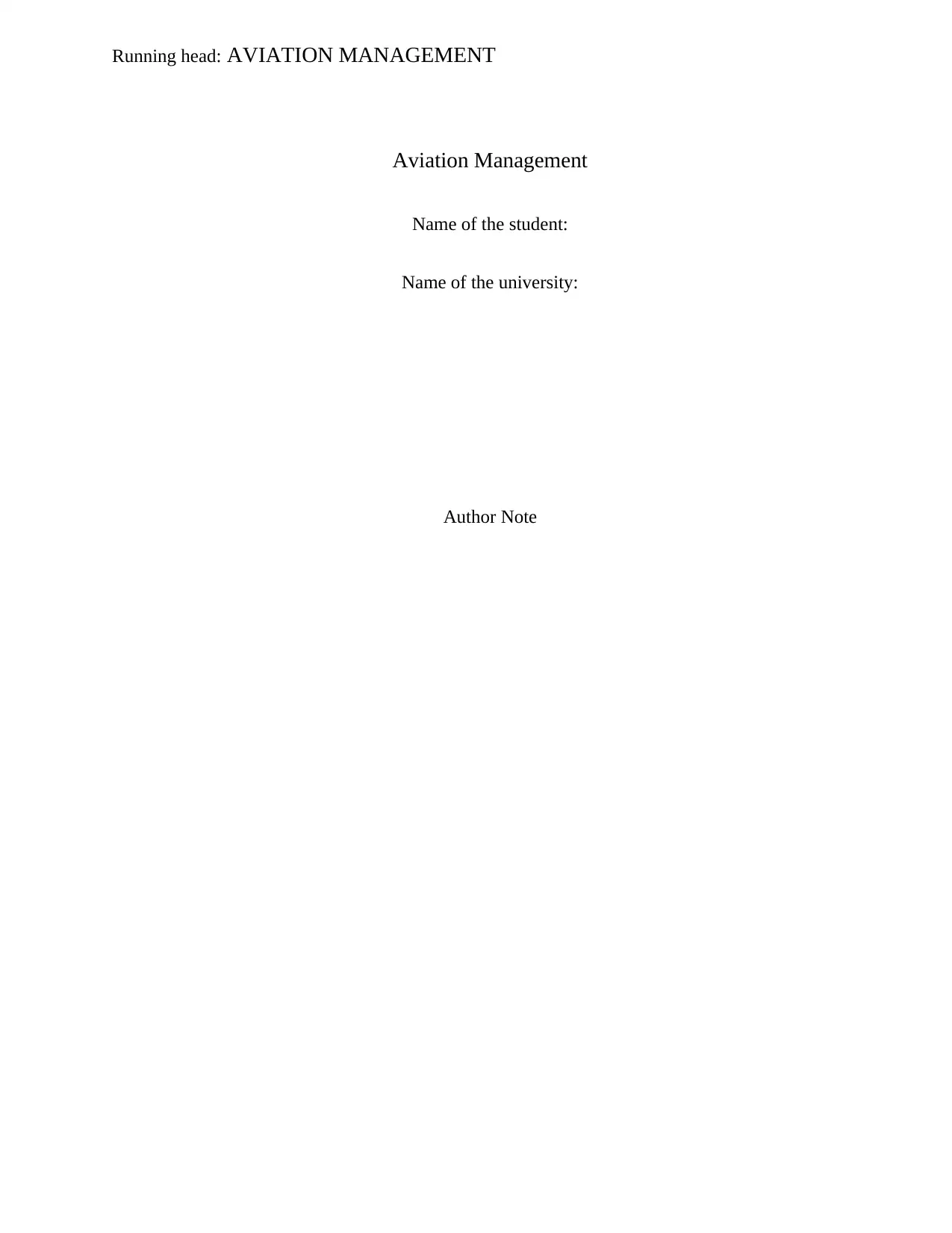
Running head: AVIATION MANAGEMENT
Aviation Management
Name of the student:
Name of the university:
Author Note
Aviation Management
Name of the student:
Name of the university:
Author Note
Paraphrase This Document
Need a fresh take? Get an instant paraphrase of this document with our AI Paraphraser
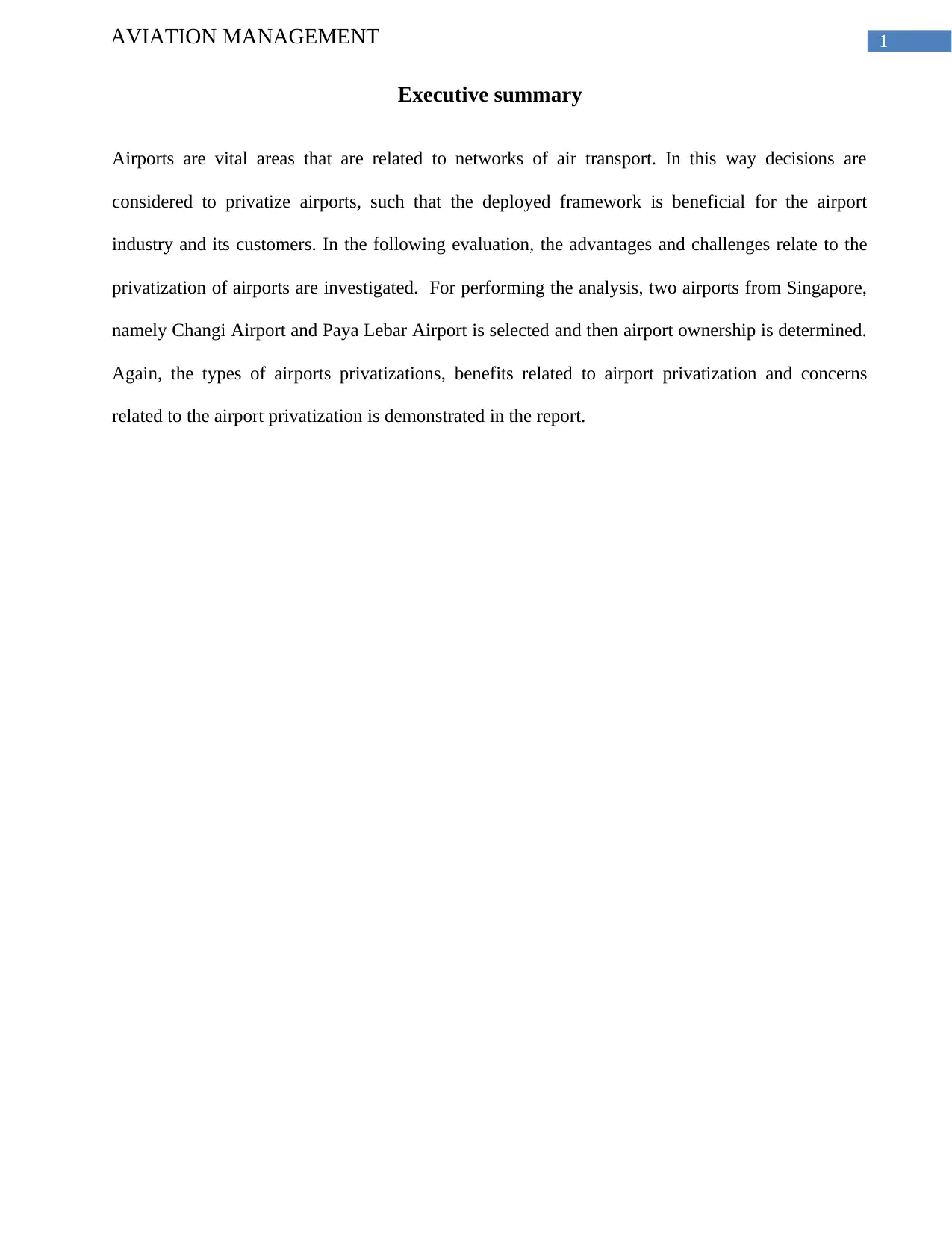
1AVIATION MANAGEMENT
Executive summary
Airports are vital areas that are related to networks of air transport. In this way decisions are
considered to privatize airports, such that the deployed framework is beneficial for the airport
industry and its customers. In the following evaluation, the advantages and challenges relate to the
privatization of airports are investigated. For performing the analysis, two airports from Singapore,
namely Changi Airport and Paya Lebar Airport is selected and then airport ownership is determined.
Again, the types of airports privatizations, benefits related to airport privatization and concerns
related to the airport privatization is demonstrated in the report.
Executive summary
Airports are vital areas that are related to networks of air transport. In this way decisions are
considered to privatize airports, such that the deployed framework is beneficial for the airport
industry and its customers. In the following evaluation, the advantages and challenges relate to the
privatization of airports are investigated. For performing the analysis, two airports from Singapore,
namely Changi Airport and Paya Lebar Airport is selected and then airport ownership is determined.
Again, the types of airports privatizations, benefits related to airport privatization and concerns
related to the airport privatization is demonstrated in the report.
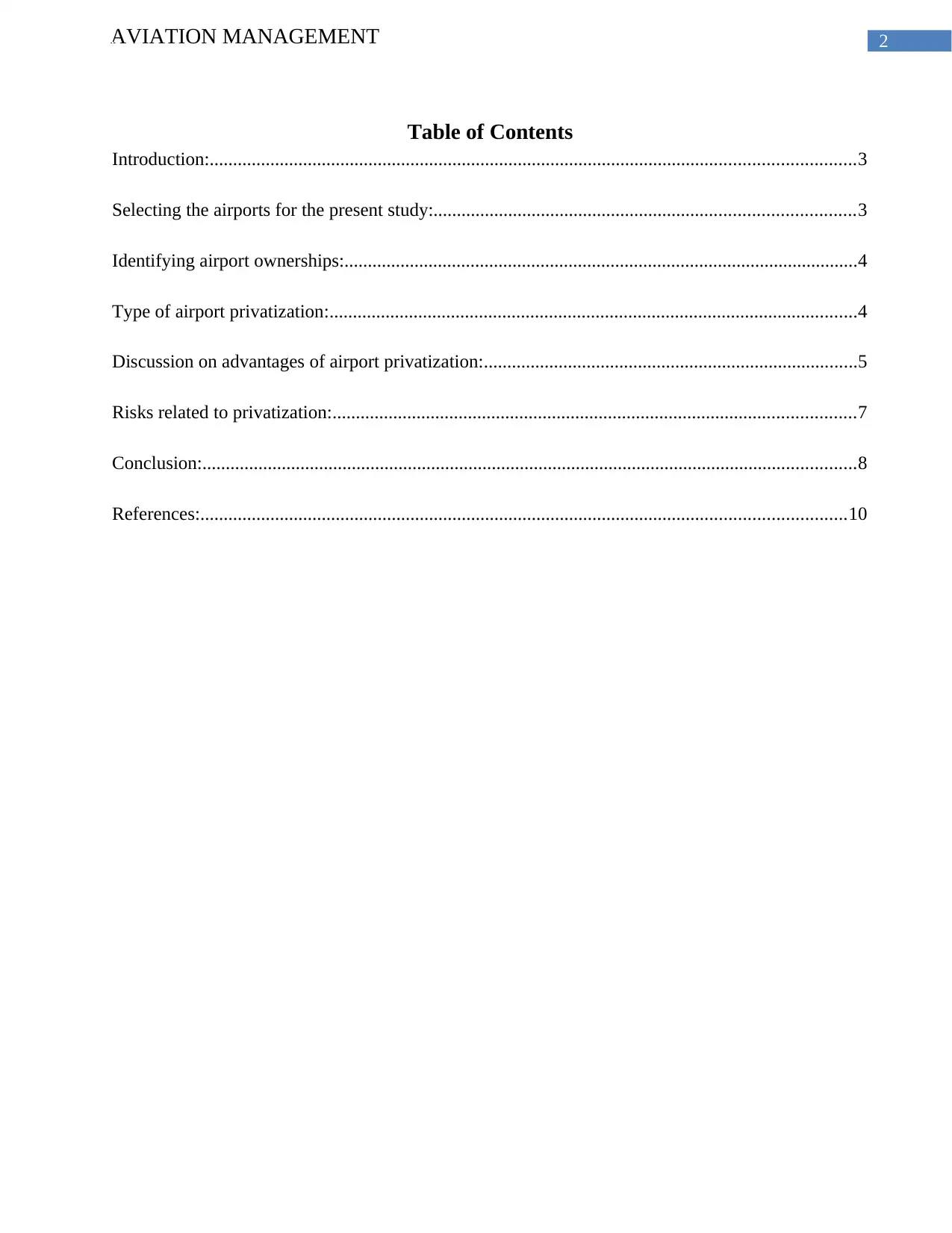
2AVIATION MANAGEMENT
Table of Contents
Introduction:..........................................................................................................................................3
Selecting the airports for the present study:..........................................................................................3
Identifying airport ownerships:..............................................................................................................4
Type of airport privatization:.................................................................................................................4
Discussion on advantages of airport privatization:................................................................................5
Risks related to privatization:................................................................................................................7
Conclusion:............................................................................................................................................8
References:..........................................................................................................................................10
Table of Contents
Introduction:..........................................................................................................................................3
Selecting the airports for the present study:..........................................................................................3
Identifying airport ownerships:..............................................................................................................4
Type of airport privatization:.................................................................................................................4
Discussion on advantages of airport privatization:................................................................................5
Risks related to privatization:................................................................................................................7
Conclusion:............................................................................................................................................8
References:..........................................................................................................................................10
⊘ This is a preview!⊘
Do you want full access?
Subscribe today to unlock all pages.

Trusted by 1+ million students worldwide
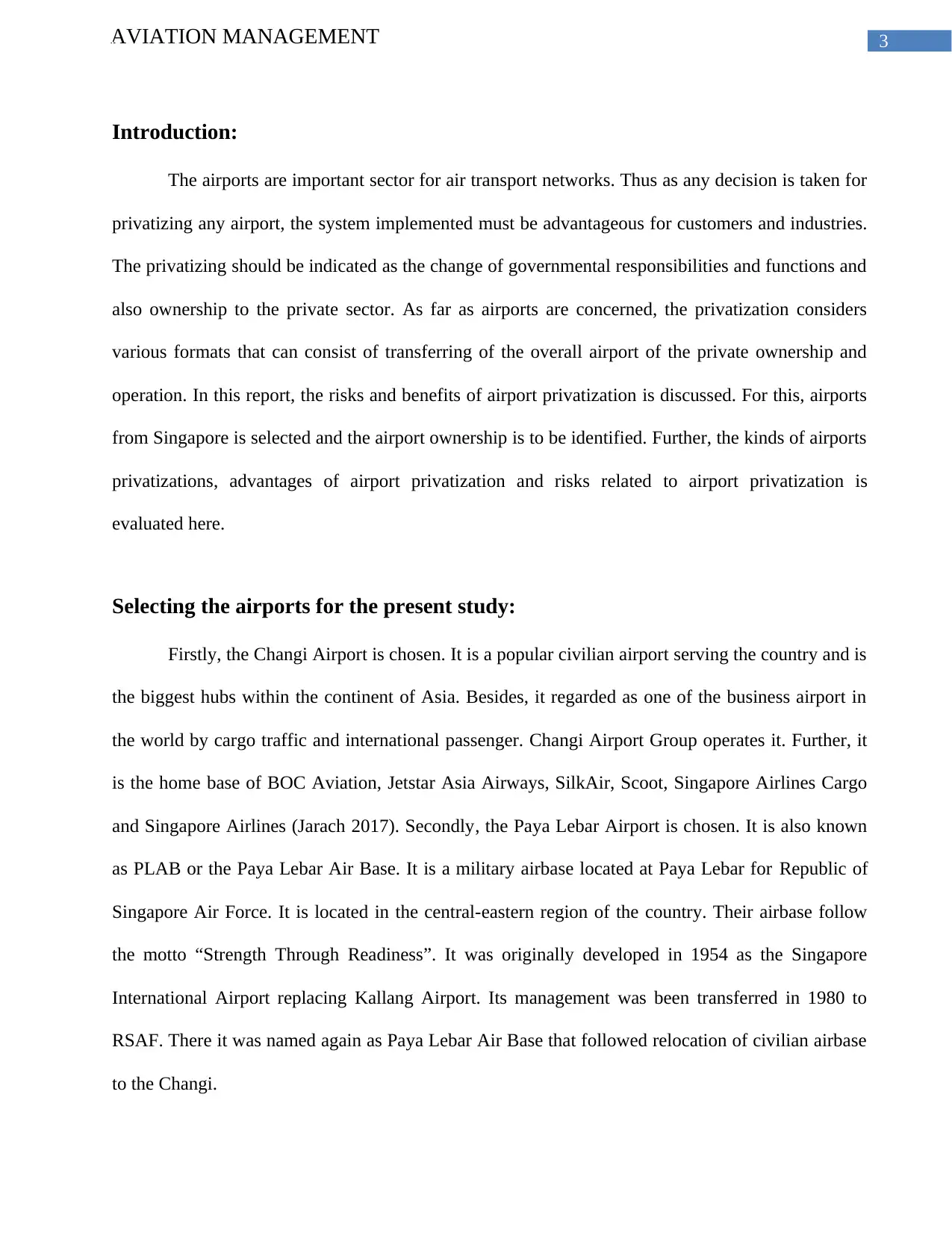
3AVIATION MANAGEMENT
Introduction:
The airports are important sector for air transport networks. Thus as any decision is taken for
privatizing any airport, the system implemented must be advantageous for customers and industries.
The privatizing should be indicated as the change of governmental responsibilities and functions and
also ownership to the private sector. As far as airports are concerned, the privatization considers
various formats that can consist of transferring of the overall airport of the private ownership and
operation. In this report, the risks and benefits of airport privatization is discussed. For this, airports
from Singapore is selected and the airport ownership is to be identified. Further, the kinds of airports
privatizations, advantages of airport privatization and risks related to airport privatization is
evaluated here.
Selecting the airports for the present study:
Firstly, the Changi Airport is chosen. It is a popular civilian airport serving the country and is
the biggest hubs within the continent of Asia. Besides, it regarded as one of the business airport in
the world by cargo traffic and international passenger. Changi Airport Group operates it. Further, it
is the home base of BOC Aviation, Jetstar Asia Airways, SilkAir, Scoot, Singapore Airlines Cargo
and Singapore Airlines (Jarach 2017). Secondly, the Paya Lebar Airport is chosen. It is also known
as PLAB or the Paya Lebar Air Base. It is a military airbase located at Paya Lebar for Republic of
Singapore Air Force. It is located in the central-eastern region of the country. Their airbase follow
the motto “Strength Through Readiness”. It was originally developed in 1954 as the Singapore
International Airport replacing Kallang Airport. Its management was been transferred in 1980 to
RSAF. There it was named again as Paya Lebar Air Base that followed relocation of civilian airbase
to the Changi.
Introduction:
The airports are important sector for air transport networks. Thus as any decision is taken for
privatizing any airport, the system implemented must be advantageous for customers and industries.
The privatizing should be indicated as the change of governmental responsibilities and functions and
also ownership to the private sector. As far as airports are concerned, the privatization considers
various formats that can consist of transferring of the overall airport of the private ownership and
operation. In this report, the risks and benefits of airport privatization is discussed. For this, airports
from Singapore is selected and the airport ownership is to be identified. Further, the kinds of airports
privatizations, advantages of airport privatization and risks related to airport privatization is
evaluated here.
Selecting the airports for the present study:
Firstly, the Changi Airport is chosen. It is a popular civilian airport serving the country and is
the biggest hubs within the continent of Asia. Besides, it regarded as one of the business airport in
the world by cargo traffic and international passenger. Changi Airport Group operates it. Further, it
is the home base of BOC Aviation, Jetstar Asia Airways, SilkAir, Scoot, Singapore Airlines Cargo
and Singapore Airlines (Jarach 2017). Secondly, the Paya Lebar Airport is chosen. It is also known
as PLAB or the Paya Lebar Air Base. It is a military airbase located at Paya Lebar for Republic of
Singapore Air Force. It is located in the central-eastern region of the country. Their airbase follow
the motto “Strength Through Readiness”. It was originally developed in 1954 as the Singapore
International Airport replacing Kallang Airport. Its management was been transferred in 1980 to
RSAF. There it was named again as Paya Lebar Air Base that followed relocation of civilian airbase
to the Changi.
Paraphrase This Document
Need a fresh take? Get an instant paraphrase of this document with our AI Paraphraser
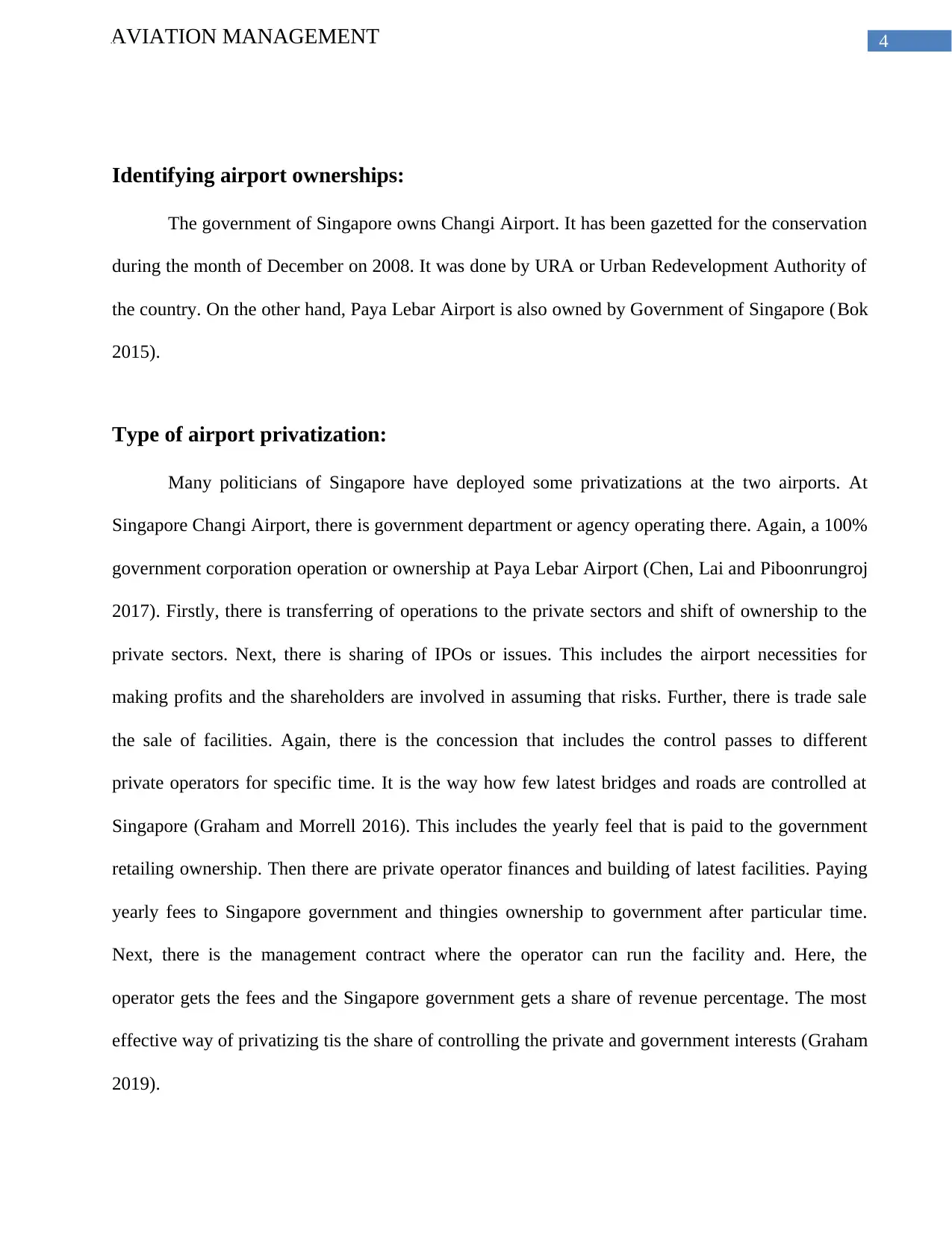
4AVIATION MANAGEMENT
Identifying airport ownerships:
The government of Singapore owns Changi Airport. It has been gazetted for the conservation
during the month of December on 2008. It was done by URA or Urban Redevelopment Authority of
the country. On the other hand, Paya Lebar Airport is also owned by Government of Singapore (Bok
2015).
Type of airport privatization:
Many politicians of Singapore have deployed some privatizations at the two airports. At
Singapore Changi Airport, there is government department or agency operating there. Again, a 100%
government corporation operation or ownership at Paya Lebar Airport (Chen, Lai and Piboonrungroj
2017). Firstly, there is transferring of operations to the private sectors and shift of ownership to the
private sectors. Next, there is sharing of IPOs or issues. This includes the airport necessities for
making profits and the shareholders are involved in assuming that risks. Further, there is trade sale
the sale of facilities. Again, there is the concession that includes the control passes to different
private operators for specific time. It is the way how few latest bridges and roads are controlled at
Singapore (Graham and Morrell 2016). This includes the yearly feel that is paid to the government
retailing ownership. Then there are private operator finances and building of latest facilities. Paying
yearly fees to Singapore government and thingies ownership to government after particular time.
Next, there is the management contract where the operator can run the facility and. Here, the
operator gets the fees and the Singapore government gets a share of revenue percentage. The most
effective way of privatizing tis the share of controlling the private and government interests (Graham
2019).
Identifying airport ownerships:
The government of Singapore owns Changi Airport. It has been gazetted for the conservation
during the month of December on 2008. It was done by URA or Urban Redevelopment Authority of
the country. On the other hand, Paya Lebar Airport is also owned by Government of Singapore (Bok
2015).
Type of airport privatization:
Many politicians of Singapore have deployed some privatizations at the two airports. At
Singapore Changi Airport, there is government department or agency operating there. Again, a 100%
government corporation operation or ownership at Paya Lebar Airport (Chen, Lai and Piboonrungroj
2017). Firstly, there is transferring of operations to the private sectors and shift of ownership to the
private sectors. Next, there is sharing of IPOs or issues. This includes the airport necessities for
making profits and the shareholders are involved in assuming that risks. Further, there is trade sale
the sale of facilities. Again, there is the concession that includes the control passes to different
private operators for specific time. It is the way how few latest bridges and roads are controlled at
Singapore (Graham and Morrell 2016). This includes the yearly feel that is paid to the government
retailing ownership. Then there are private operator finances and building of latest facilities. Paying
yearly fees to Singapore government and thingies ownership to government after particular time.
Next, there is the management contract where the operator can run the facility and. Here, the
operator gets the fees and the Singapore government gets a share of revenue percentage. The most
effective way of privatizing tis the share of controlling the private and government interests (Graham
2019).
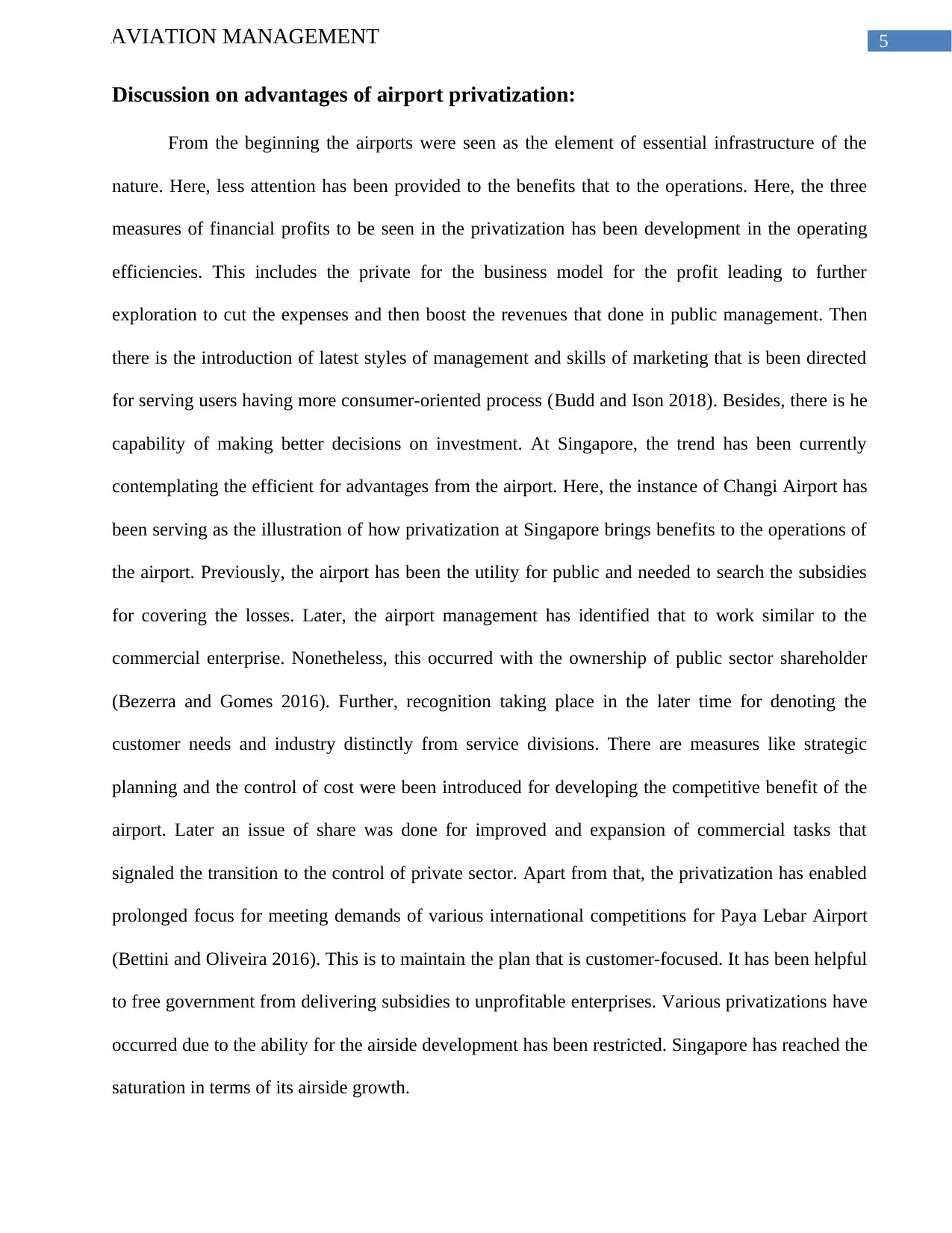
5AVIATION MANAGEMENT
Discussion on advantages of airport privatization:
From the beginning the airports were seen as the element of essential infrastructure of the
nature. Here, less attention has been provided to the benefits that to the operations. Here, the three
measures of financial profits to be seen in the privatization has been development in the operating
efficiencies. This includes the private for the business model for the profit leading to further
exploration to cut the expenses and then boost the revenues that done in public management. Then
there is the introduction of latest styles of management and skills of marketing that is been directed
for serving users having more consumer-oriented process (Budd and Ison 2018). Besides, there is he
capability of making better decisions on investment. At Singapore, the trend has been currently
contemplating the efficient for advantages from the airport. Here, the instance of Changi Airport has
been serving as the illustration of how privatization at Singapore brings benefits to the operations of
the airport. Previously, the airport has been the utility for public and needed to search the subsidies
for covering the losses. Later, the airport management has identified that to work similar to the
commercial enterprise. Nonetheless, this occurred with the ownership of public sector shareholder
(Bezerra and Gomes 2016). Further, recognition taking place in the later time for denoting the
customer needs and industry distinctly from service divisions. There are measures like strategic
planning and the control of cost were been introduced for developing the competitive benefit of the
airport. Later an issue of share was done for improved and expansion of commercial tasks that
signaled the transition to the control of private sector. Apart from that, the privatization has enabled
prolonged focus for meeting demands of various international competitions for Paya Lebar Airport
(Bettini and Oliveira 2016). This is to maintain the plan that is customer-focused. It has been helpful
to free government from delivering subsidies to unprofitable enterprises. Various privatizations have
occurred due to the ability for the airside development has been restricted. Singapore has reached the
saturation in terms of its airside growth.
Discussion on advantages of airport privatization:
From the beginning the airports were seen as the element of essential infrastructure of the
nature. Here, less attention has been provided to the benefits that to the operations. Here, the three
measures of financial profits to be seen in the privatization has been development in the operating
efficiencies. This includes the private for the business model for the profit leading to further
exploration to cut the expenses and then boost the revenues that done in public management. Then
there is the introduction of latest styles of management and skills of marketing that is been directed
for serving users having more consumer-oriented process (Budd and Ison 2018). Besides, there is he
capability of making better decisions on investment. At Singapore, the trend has been currently
contemplating the efficient for advantages from the airport. Here, the instance of Changi Airport has
been serving as the illustration of how privatization at Singapore brings benefits to the operations of
the airport. Previously, the airport has been the utility for public and needed to search the subsidies
for covering the losses. Later, the airport management has identified that to work similar to the
commercial enterprise. Nonetheless, this occurred with the ownership of public sector shareholder
(Bezerra and Gomes 2016). Further, recognition taking place in the later time for denoting the
customer needs and industry distinctly from service divisions. There are measures like strategic
planning and the control of cost were been introduced for developing the competitive benefit of the
airport. Later an issue of share was done for improved and expansion of commercial tasks that
signaled the transition to the control of private sector. Apart from that, the privatization has enabled
prolonged focus for meeting demands of various international competitions for Paya Lebar Airport
(Bettini and Oliveira 2016). This is to maintain the plan that is customer-focused. It has been helpful
to free government from delivering subsidies to unprofitable enterprises. Various privatizations have
occurred due to the ability for the airside development has been restricted. Singapore has reached the
saturation in terms of its airside growth.
⊘ This is a preview!⊘
Do you want full access?
Subscribe today to unlock all pages.

Trusted by 1+ million students worldwide
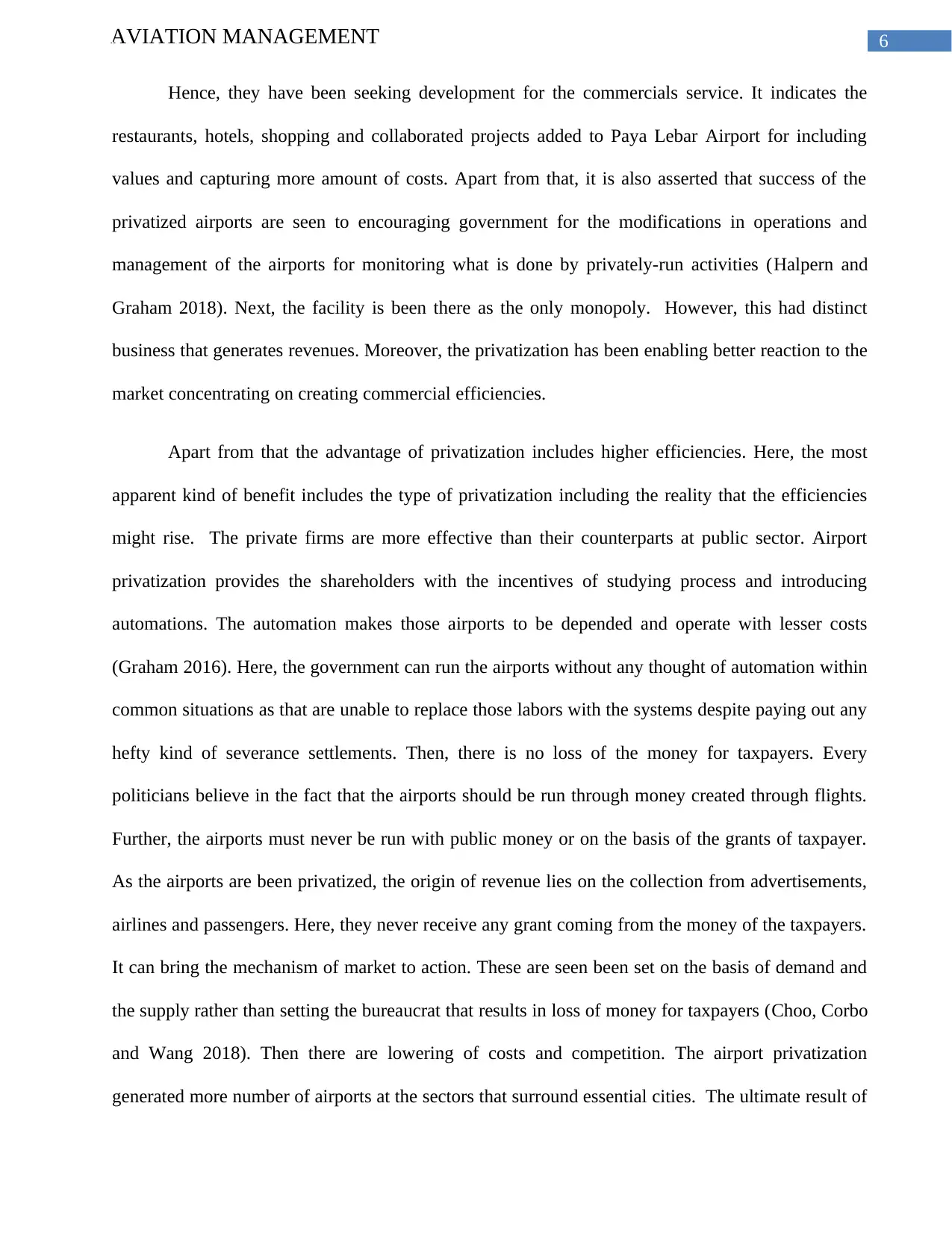
6AVIATION MANAGEMENT
Hence, they have been seeking development for the commercials service. It indicates the
restaurants, hotels, shopping and collaborated projects added to Paya Lebar Airport for including
values and capturing more amount of costs. Apart from that, it is also asserted that success of the
privatized airports are seen to encouraging government for the modifications in operations and
management of the airports for monitoring what is done by privately-run activities (Halpern and
Graham 2018). Next, the facility is been there as the only monopoly. However, this had distinct
business that generates revenues. Moreover, the privatization has been enabling better reaction to the
market concentrating on creating commercial efficiencies.
Apart from that the advantage of privatization includes higher efficiencies. Here, the most
apparent kind of benefit includes the type of privatization including the reality that the efficiencies
might rise. The private firms are more effective than their counterparts at public sector. Airport
privatization provides the shareholders with the incentives of studying process and introducing
automations. The automation makes those airports to be depended and operate with lesser costs
(Graham 2016). Here, the government can run the airports without any thought of automation within
common situations as that are unable to replace those labors with the systems despite paying out any
hefty kind of severance settlements. Then, there is no loss of the money for taxpayers. Every
politicians believe in the fact that the airports should be run through money created through flights.
Further, the airports must never be run with public money or on the basis of the grants of taxpayer.
As the airports are been privatized, the origin of revenue lies on the collection from advertisements,
airlines and passengers. Here, they never receive any grant coming from the money of the taxpayers.
It can bring the mechanism of market to action. These are seen been set on the basis of demand and
the supply rather than setting the bureaucrat that results in loss of money for taxpayers (Choo, Corbo
and Wang 2018). Then there are lowering of costs and competition. The airport privatization
generated more number of airports at the sectors that surround essential cities. The ultimate result of
Hence, they have been seeking development for the commercials service. It indicates the
restaurants, hotels, shopping and collaborated projects added to Paya Lebar Airport for including
values and capturing more amount of costs. Apart from that, it is also asserted that success of the
privatized airports are seen to encouraging government for the modifications in operations and
management of the airports for monitoring what is done by privately-run activities (Halpern and
Graham 2018). Next, the facility is been there as the only monopoly. However, this had distinct
business that generates revenues. Moreover, the privatization has been enabling better reaction to the
market concentrating on creating commercial efficiencies.
Apart from that the advantage of privatization includes higher efficiencies. Here, the most
apparent kind of benefit includes the type of privatization including the reality that the efficiencies
might rise. The private firms are more effective than their counterparts at public sector. Airport
privatization provides the shareholders with the incentives of studying process and introducing
automations. The automation makes those airports to be depended and operate with lesser costs
(Graham 2016). Here, the government can run the airports without any thought of automation within
common situations as that are unable to replace those labors with the systems despite paying out any
hefty kind of severance settlements. Then, there is no loss of the money for taxpayers. Every
politicians believe in the fact that the airports should be run through money created through flights.
Further, the airports must never be run with public money or on the basis of the grants of taxpayer.
As the airports are been privatized, the origin of revenue lies on the collection from advertisements,
airlines and passengers. Here, they never receive any grant coming from the money of the taxpayers.
It can bring the mechanism of market to action. These are seen been set on the basis of demand and
the supply rather than setting the bureaucrat that results in loss of money for taxpayers (Choo, Corbo
and Wang 2018). Then there are lowering of costs and competition. The airport privatization
generated more number of airports at the sectors that surround essential cities. The ultimate result of
Paraphrase This Document
Need a fresh take? Get an instant paraphrase of this document with our AI Paraphraser
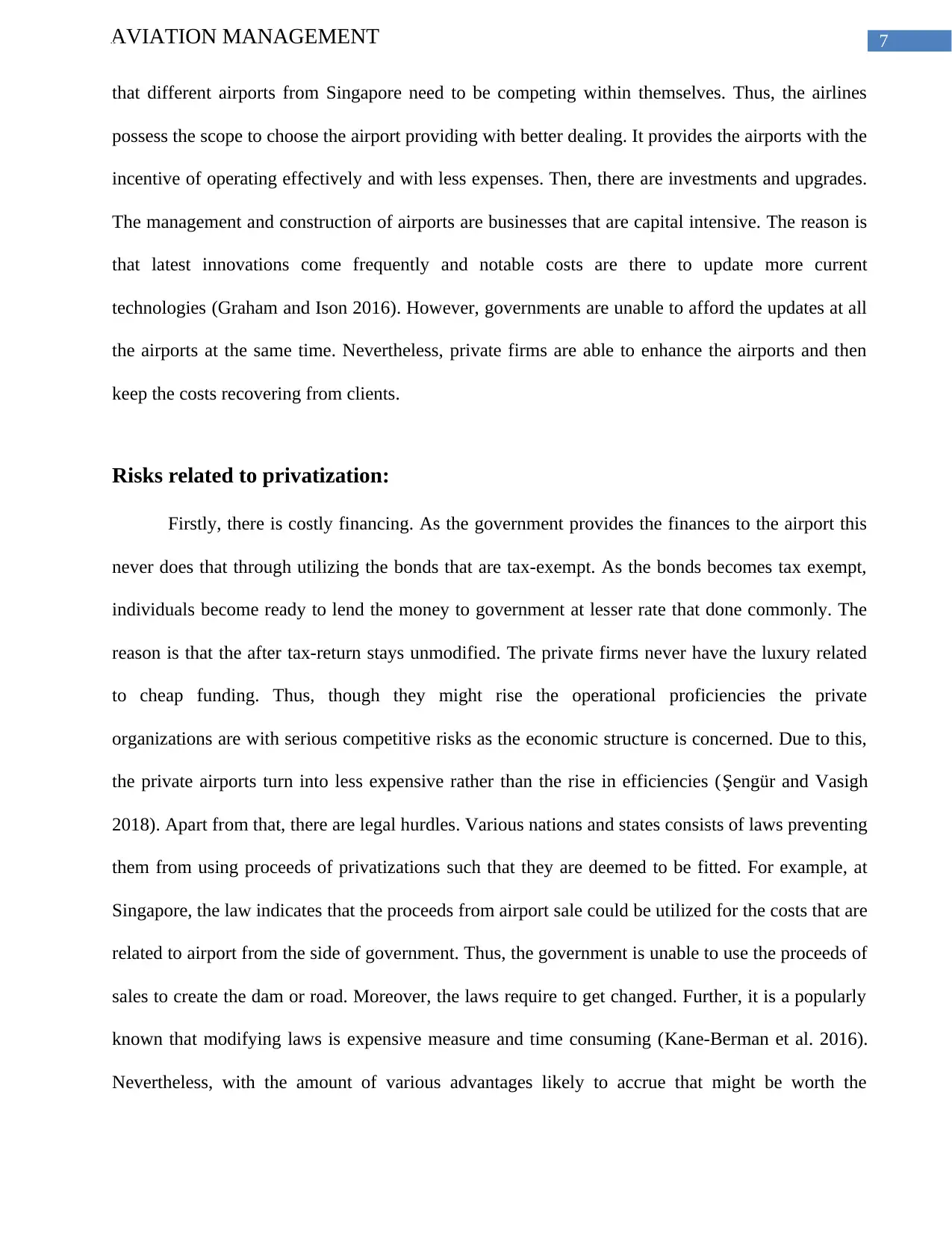
7AVIATION MANAGEMENT
that different airports from Singapore need to be competing within themselves. Thus, the airlines
possess the scope to choose the airport providing with better dealing. It provides the airports with the
incentive of operating effectively and with less expenses. Then, there are investments and upgrades.
The management and construction of airports are businesses that are capital intensive. The reason is
that latest innovations come frequently and notable costs are there to update more current
technologies (Graham and Ison 2016). However, governments are unable to afford the updates at all
the airports at the same time. Nevertheless, private firms are able to enhance the airports and then
keep the costs recovering from clients.
Risks related to privatization:
Firstly, there is costly financing. As the government provides the finances to the airport this
never does that through utilizing the bonds that are tax-exempt. As the bonds becomes tax exempt,
individuals become ready to lend the money to government at lesser rate that done commonly. The
reason is that the after tax-return stays unmodified. The private firms never have the luxury related
to cheap funding. Thus, though they might rise the operational proficiencies the private
organizations are with serious competitive risks as the economic structure is concerned. Due to this,
the private airports turn into less expensive rather than the rise in efficiencies (Şengür and Vasigh
2018). Apart from that, there are legal hurdles. Various nations and states consists of laws preventing
them from using proceeds of privatizations such that they are deemed to be fitted. For example, at
Singapore, the law indicates that the proceeds from airport sale could be utilized for the costs that are
related to airport from the side of government. Thus, the government is unable to use the proceeds of
sales to create the dam or road. Moreover, the laws require to get changed. Further, it is a popularly
known that modifying laws is expensive measure and time consuming (Kane-Berman et al. 2016).
Nevertheless, with the amount of various advantages likely to accrue that might be worth the
that different airports from Singapore need to be competing within themselves. Thus, the airlines
possess the scope to choose the airport providing with better dealing. It provides the airports with the
incentive of operating effectively and with less expenses. Then, there are investments and upgrades.
The management and construction of airports are businesses that are capital intensive. The reason is
that latest innovations come frequently and notable costs are there to update more current
technologies (Graham and Ison 2016). However, governments are unable to afford the updates at all
the airports at the same time. Nevertheless, private firms are able to enhance the airports and then
keep the costs recovering from clients.
Risks related to privatization:
Firstly, there is costly financing. As the government provides the finances to the airport this
never does that through utilizing the bonds that are tax-exempt. As the bonds becomes tax exempt,
individuals become ready to lend the money to government at lesser rate that done commonly. The
reason is that the after tax-return stays unmodified. The private firms never have the luxury related
to cheap funding. Thus, though they might rise the operational proficiencies the private
organizations are with serious competitive risks as the economic structure is concerned. Due to this,
the private airports turn into less expensive rather than the rise in efficiencies (Şengür and Vasigh
2018). Apart from that, there are legal hurdles. Various nations and states consists of laws preventing
them from using proceeds of privatizations such that they are deemed to be fitted. For example, at
Singapore, the law indicates that the proceeds from airport sale could be utilized for the costs that are
related to airport from the side of government. Thus, the government is unable to use the proceeds of
sales to create the dam or road. Moreover, the laws require to get changed. Further, it is a popularly
known that modifying laws is expensive measure and time consuming (Kane-Berman et al. 2016).
Nevertheless, with the amount of various advantages likely to accrue that might be worth the
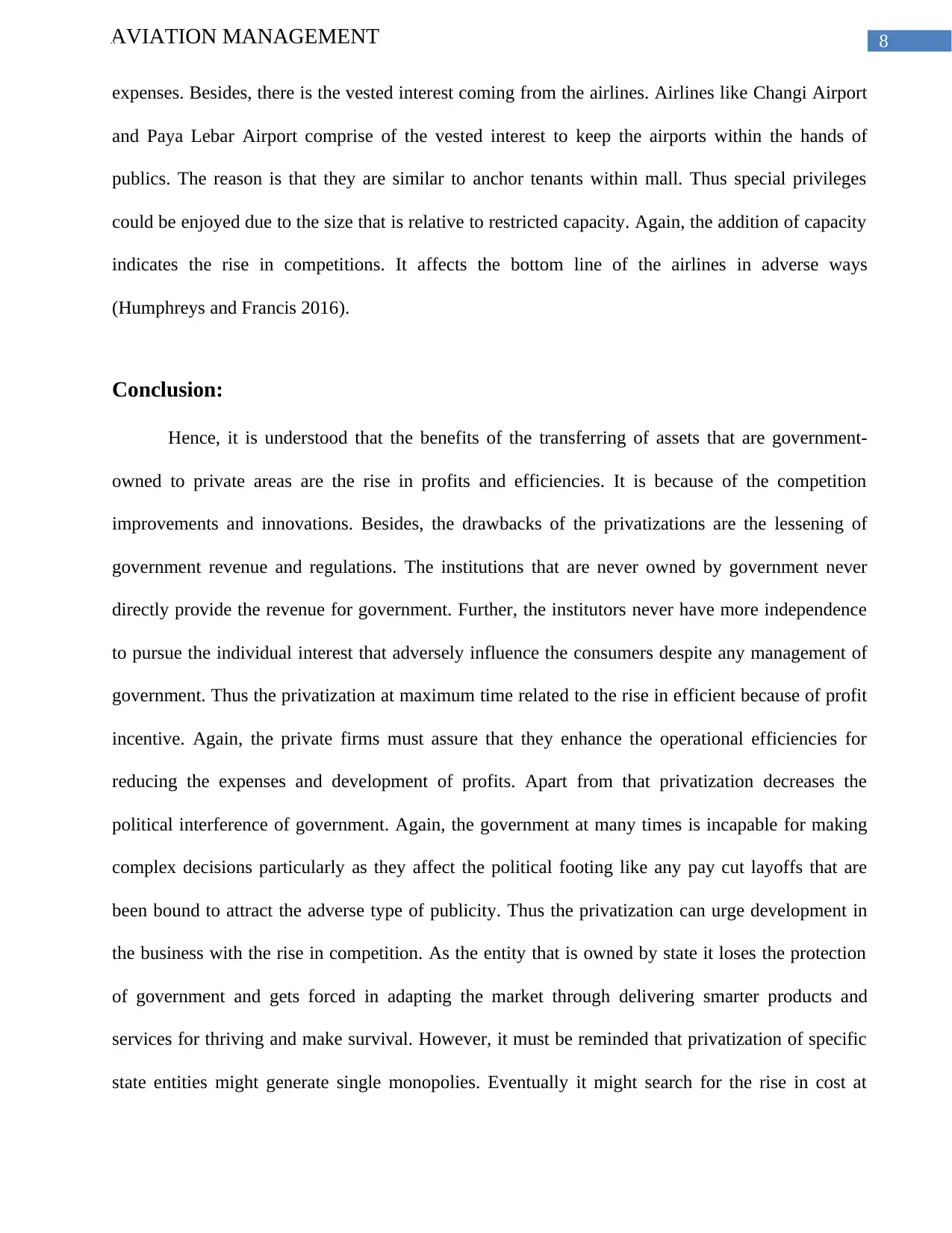
8AVIATION MANAGEMENT
expenses. Besides, there is the vested interest coming from the airlines. Airlines like Changi Airport
and Paya Lebar Airport comprise of the vested interest to keep the airports within the hands of
publics. The reason is that they are similar to anchor tenants within mall. Thus special privileges
could be enjoyed due to the size that is relative to restricted capacity. Again, the addition of capacity
indicates the rise in competitions. It affects the bottom line of the airlines in adverse ways
(Humphreys and Francis 2016).
Conclusion:
Hence, it is understood that the benefits of the transferring of assets that are government-
owned to private areas are the rise in profits and efficiencies. It is because of the competition
improvements and innovations. Besides, the drawbacks of the privatizations are the lessening of
government revenue and regulations. The institutions that are never owned by government never
directly provide the revenue for government. Further, the institutors never have more independence
to pursue the individual interest that adversely influence the consumers despite any management of
government. Thus the privatization at maximum time related to the rise in efficient because of profit
incentive. Again, the private firms must assure that they enhance the operational efficiencies for
reducing the expenses and development of profits. Apart from that privatization decreases the
political interference of government. Again, the government at many times is incapable for making
complex decisions particularly as they affect the political footing like any pay cut layoffs that are
been bound to attract the adverse type of publicity. Thus the privatization can urge development in
the business with the rise in competition. As the entity that is owned by state it loses the protection
of government and gets forced in adapting the market through delivering smarter products and
services for thriving and make survival. However, it must be reminded that privatization of specific
state entities might generate single monopolies. Eventually it might search for the rise in cost at
expenses. Besides, there is the vested interest coming from the airlines. Airlines like Changi Airport
and Paya Lebar Airport comprise of the vested interest to keep the airports within the hands of
publics. The reason is that they are similar to anchor tenants within mall. Thus special privileges
could be enjoyed due to the size that is relative to restricted capacity. Again, the addition of capacity
indicates the rise in competitions. It affects the bottom line of the airlines in adverse ways
(Humphreys and Francis 2016).
Conclusion:
Hence, it is understood that the benefits of the transferring of assets that are government-
owned to private areas are the rise in profits and efficiencies. It is because of the competition
improvements and innovations. Besides, the drawbacks of the privatizations are the lessening of
government revenue and regulations. The institutions that are never owned by government never
directly provide the revenue for government. Further, the institutors never have more independence
to pursue the individual interest that adversely influence the consumers despite any management of
government. Thus the privatization at maximum time related to the rise in efficient because of profit
incentive. Again, the private firms must assure that they enhance the operational efficiencies for
reducing the expenses and development of profits. Apart from that privatization decreases the
political interference of government. Again, the government at many times is incapable for making
complex decisions particularly as they affect the political footing like any pay cut layoffs that are
been bound to attract the adverse type of publicity. Thus the privatization can urge development in
the business with the rise in competition. As the entity that is owned by state it loses the protection
of government and gets forced in adapting the market through delivering smarter products and
services for thriving and make survival. However, it must be reminded that privatization of specific
state entities might generate single monopolies. Eventually it might search for the rise in cost at
⊘ This is a preview!⊘
Do you want full access?
Subscribe today to unlock all pages.

Trusted by 1+ million students worldwide
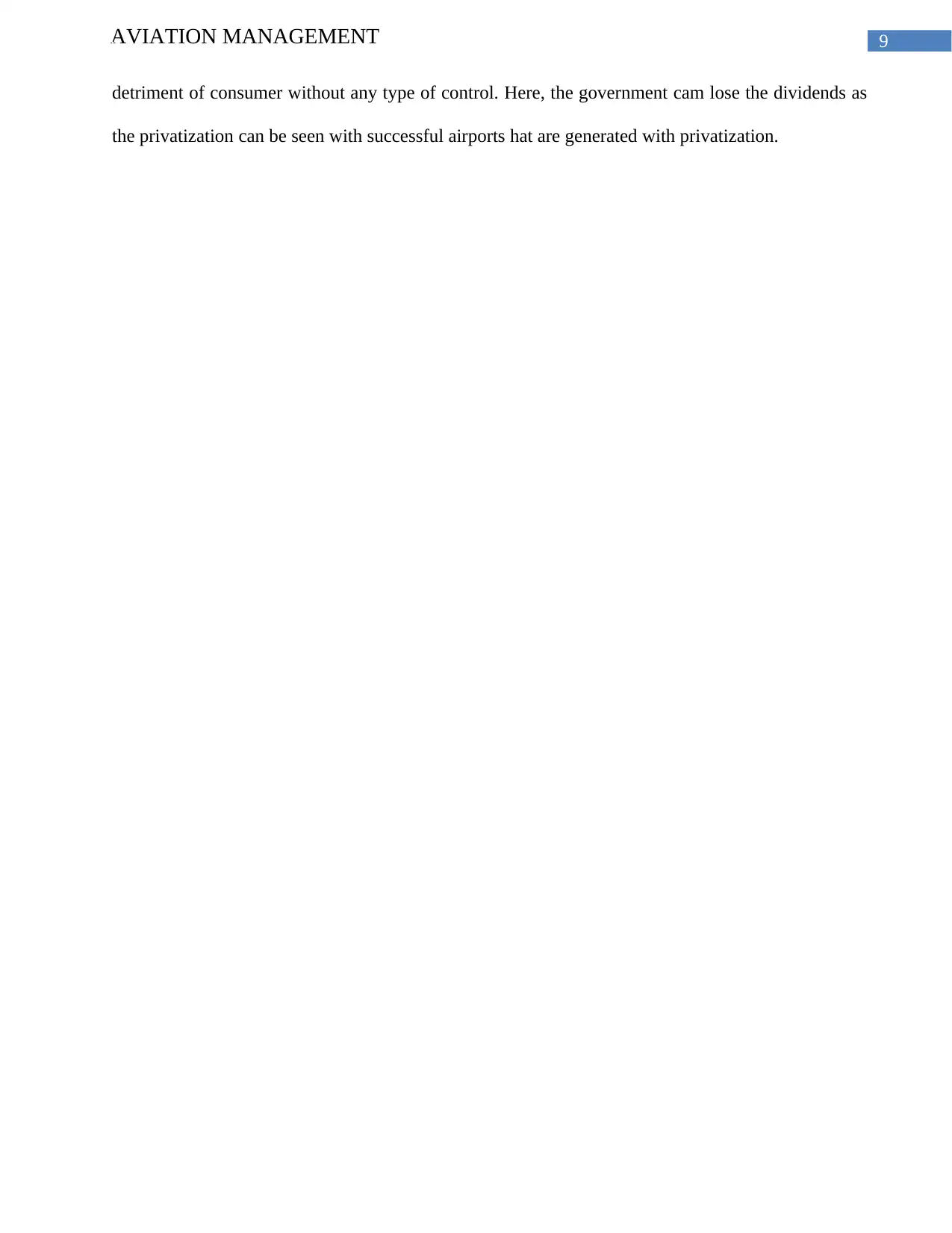
9AVIATION MANAGEMENT
detriment of consumer without any type of control. Here, the government cam lose the dividends as
the privatization can be seen with successful airports hat are generated with privatization.
detriment of consumer without any type of control. Here, the government cam lose the dividends as
the privatization can be seen with successful airports hat are generated with privatization.
Paraphrase This Document
Need a fresh take? Get an instant paraphrase of this document with our AI Paraphraser
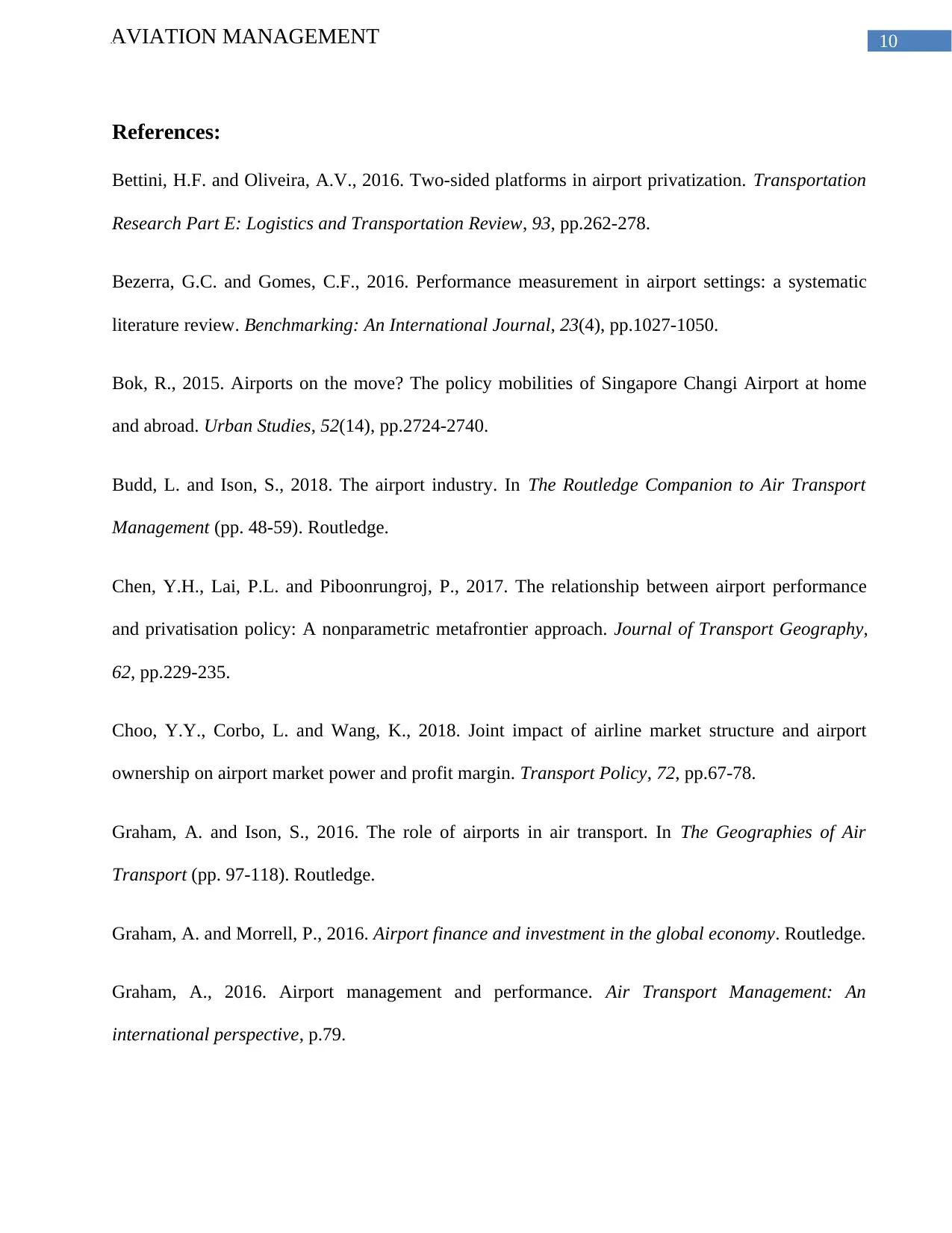
10AVIATION MANAGEMENT
References:
Bettini, H.F. and Oliveira, A.V., 2016. Two-sided platforms in airport privatization. Transportation
Research Part E: Logistics and Transportation Review, 93, pp.262-278.
Bezerra, G.C. and Gomes, C.F., 2016. Performance measurement in airport settings: a systematic
literature review. Benchmarking: An International Journal, 23(4), pp.1027-1050.
Bok, R., 2015. Airports on the move? The policy mobilities of Singapore Changi Airport at home
and abroad. Urban Studies, 52(14), pp.2724-2740.
Budd, L. and Ison, S., 2018. The airport industry. In The Routledge Companion to Air Transport
Management (pp. 48-59). Routledge.
Chen, Y.H., Lai, P.L. and Piboonrungroj, P., 2017. The relationship between airport performance
and privatisation policy: A nonparametric metafrontier approach. Journal of Transport Geography,
62, pp.229-235.
Choo, Y.Y., Corbo, L. and Wang, K., 2018. Joint impact of airline market structure and airport
ownership on airport market power and profit margin. Transport Policy, 72, pp.67-78.
Graham, A. and Ison, S., 2016. The role of airports in air transport. In The Geographies of Air
Transport (pp. 97-118). Routledge.
Graham, A. and Morrell, P., 2016. Airport finance and investment in the global economy. Routledge.
Graham, A., 2016. Airport management and performance. Air Transport Management: An
international perspective, p.79.
References:
Bettini, H.F. and Oliveira, A.V., 2016. Two-sided platforms in airport privatization. Transportation
Research Part E: Logistics and Transportation Review, 93, pp.262-278.
Bezerra, G.C. and Gomes, C.F., 2016. Performance measurement in airport settings: a systematic
literature review. Benchmarking: An International Journal, 23(4), pp.1027-1050.
Bok, R., 2015. Airports on the move? The policy mobilities of Singapore Changi Airport at home
and abroad. Urban Studies, 52(14), pp.2724-2740.
Budd, L. and Ison, S., 2018. The airport industry. In The Routledge Companion to Air Transport
Management (pp. 48-59). Routledge.
Chen, Y.H., Lai, P.L. and Piboonrungroj, P., 2017. The relationship between airport performance
and privatisation policy: A nonparametric metafrontier approach. Journal of Transport Geography,
62, pp.229-235.
Choo, Y.Y., Corbo, L. and Wang, K., 2018. Joint impact of airline market structure and airport
ownership on airport market power and profit margin. Transport Policy, 72, pp.67-78.
Graham, A. and Ison, S., 2016. The role of airports in air transport. In The Geographies of Air
Transport (pp. 97-118). Routledge.
Graham, A. and Morrell, P., 2016. Airport finance and investment in the global economy. Routledge.
Graham, A., 2016. Airport management and performance. Air Transport Management: An
international perspective, p.79.
1 out of 11
Related Documents
Your All-in-One AI-Powered Toolkit for Academic Success.
+13062052269
info@desklib.com
Available 24*7 on WhatsApp / Email
![[object Object]](/_next/static/media/star-bottom.7253800d.svg)
Unlock your academic potential
Copyright © 2020–2025 A2Z Services. All Rights Reserved. Developed and managed by ZUCOL.





